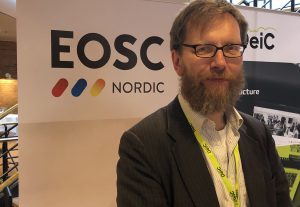Q&A
WP2.2 task leader Lars Fischer (NORDUnet)

What is your role in the EOSC-Nordic project?
The role of NORDUnet in the EOSC-Nordic is primarily policy and business model related. Some research e-infrastructure providers, like a supercomputer centre for example, are more used to being located in one building where everything happens. To them, it is a new idea to do this internationally. But for research networks like they run in DeiC, this is something that people have done for a long time. And NORDUnet, we have the experience in how to do this. We deliver centrally in the Nordic area through DeiC and then through campuses and so on. Therefore, we are leading a task that looks at various Nordic stakeholders and interviews them about the requirements and talks about likely business models. What are the models now, and what will they be when we have EOSC. We also look at the baby steps taken by EOSC, and consider how we can add value. Because the Nordic countries are much better at collaborating internationally with infrastructure than most of Europe, so we can add something special here.
What is the greatest challenge for the EOSC-Nordic project?
The greatest challenge for the EOSC-Nordic project is, that there is a lot of people who have very good ideas about what EOSC is, but they mainly have different ideas. And so, figuring out what it is we are actually supposed to do, and finding the business model, is going to be a challenge.
The resources that have been set aside in Denmark for high-end physics can’t just be used in Finland for astronomy, because it is a different budget that has funded it. You can’t just move things around like that. And most of the infrastructure, no matter how we do it, is going to be national. Denmark is paying an additional 10 million euros for infrastructure, but that is for Danish researchers and not for Austrian researchers. So maybe EOSC isn’t really about infrastructure maybe it is about coordinating data and making sure researchers have access to data. And all the infrastructure is just something that we federate and make sure happens, so it supports this vision of shared data. But we have to decide, is it the sharing of data, or is it this big monstrous centralized service provider, that is EOSC. Because some people would like to see EOSC as the Google for research. The search engine where you find everything. But for some people, Google is also the place, where they have your email and your photo catalogue, they have everything you use. And it might not become that. So, we have to decide what EOSC is supposed to be. Once we know that, I think we can advance.
What do we accomplish with the EOSC-Nordic project?
More than anything, I think that what the Nordic countries can bring, is this sharing and collaboration that is traditional in Nordic infrastructures, and facilitate the sharing of research data. Because I think that is the real value. A lot of research data is produced in a laboratory somewhere and used exactly once to write a paper. Whereas in certain disciplines they are really really super good at this. For example, to use the Hubble Space Telescope you need to send in an application. But a few years ago, they made an analysis that showed, that only about a third of the papers produced from Hubble observations are produced by people who got the grant. Two thirds of the papers were written later by people who just found the data in the archive. And that is super important. If we can get to a place where more of that happens in other disciplines, that would be the real contribution. And I think the Nordic countries have a role to play in that, because we have that tradition in sharing data. And if we can bring that to the rest of Europe, we really produce value.